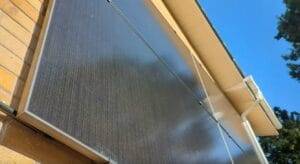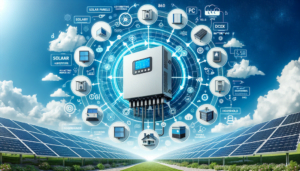Unlock the full potential of solar energy with overpaneling. Maximise efficiency and power output for a productive solar harvest.
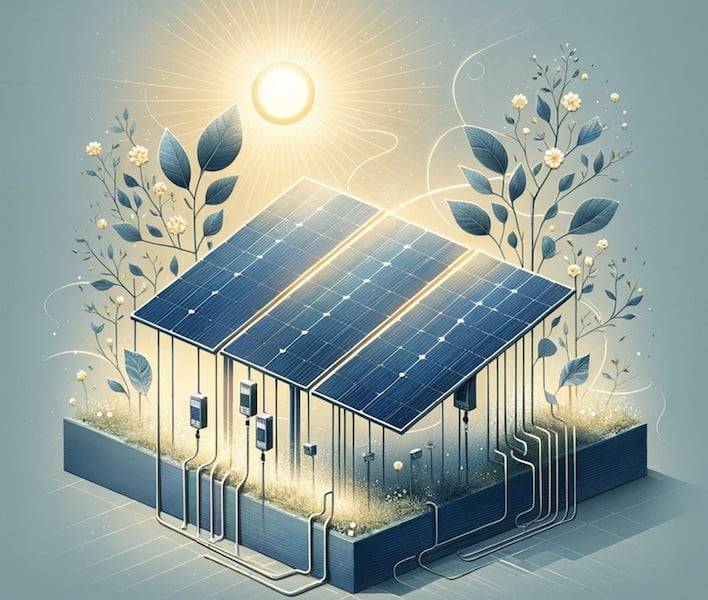
Overpaneling is a strategic approach to solar panel installation. It involves deploying a solar array with a capacity exceeding the inverter’s rated output.
You might think this is unsafe. But don’t worry! There is a way to do it safely.
By understanding the principles and benefits of overpaneling, homeowners can optimise their solar energy systems for enhanced performance and sustainability.
It has no significant downside; you should consider it for your system.
What is Overpaneling?
With overpaneling, your solar array’s peak power exceeds your inverter’s rated AC power. An example is connecting 10kWp (ten kilowatts peak) solar panel capacity to an inverter rated at 8kW AC.
What are the Benefits of Overpaneling?
Overpaneling is especially helpful on gloomy days and brings opportunities on sunny days. Solar panels perform below their peak power production most of the time. Peak power performance depends on temperature, sun angle, direction, age of the panels and clear sky conditions, so you rarely achieve it.
We can see the expected solar PV power in various conditions as shown in this paper on Solar Power Forecasting Using Weather Type Clustering and Ensembles of Neural Networks by the Australian Energy Research Institute The University of New South Wales Sydney, NSW, Australia.
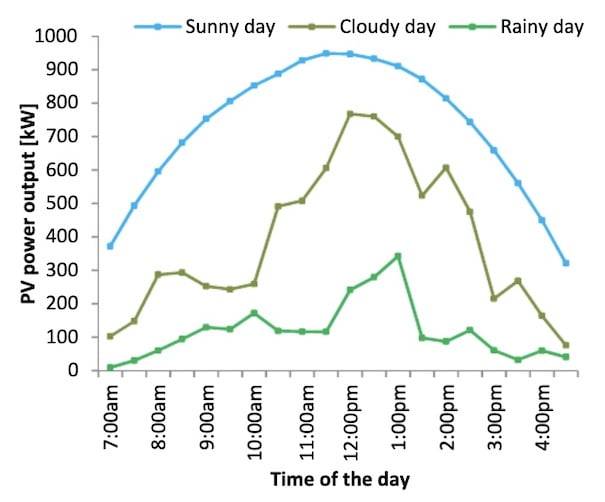
Adding more panels can compensate for suboptimal conditions.
Improved Solar Power Harvest On Cloudy Days
Overpaneling compensates for your system’s reduced efficiency on gloomy days. Solar energy systems see a notable drop in power production on cloudy days. Sometimes, this means homeowners have to buy extra energy from the grid.
Here’s an interpretation of the above graphic, but with overpaneling. We see some unrealised potential on days with optimal conditions. However, this loss’s real value is significantly smaller than the total.

Utilisation of Excess Energy
In optimal conditions, additional panels produce more DC energy than your inverter can convert to AC. Many hybrid inverters can direct part of this DC electricity into the battery. Thus, the inverter can produce AC electricity at its rated power yet still utilise more than that in DC.
Improved inverter efficiency
Provisioning more PV power can help ensure your inverter operates at its peak efficiency for longer. Thus, even more precious solar energy is harvested on cloudy days. Inverter designs are often optimised to achieve peak efficiency within a specific power output range. Typically, this range is around 50% to 80% of the inverter’s rated capacity. Operating within this range allows the inverter to minimise losses.
Research by Sandia National Laboratories in the US shows this in a graph.
Overpaneling Gets You Better Return On Investment
Without overpaneling, a 5.88 kW system with a 5 kW inverter generates about 8,000 kWh annually, saving £1,200 annually. With overpaneling, a 7.56 kW system with the same inverter produces approximately 10,500 kWh annually, saving £1,575 annually. The initial costs I am using are extra high for the overpaneling case. I did that to emphasise the improved ROI and reduced payback period ot show what a worthwhile investment it is.
| Aspect | Without Overpaneling | With Overpaneling |
|---|---|---|
| Number of Panels | 14 x 420Wp | 18 x 420Wp |
| System Size (kW) | 5.88 | 7.56 |
| Energy Production (kWh/year) | 8,000 | 10,500 |
| Initial Cost (£) | 5,000 | 6,500 |
| Annual Savings (£) | 1,200 | 1,575 |
| ROI (%) | 24 | 24.2 |
| Payback Period (Years) | 4.17 | 4.13 |
| Total Cost (£) | 5,000 | 6,500 |
Technical Considerations
Adding more panels has its limits. The first limit you’ll likely encounter is around DC voltage. Your inverter specification will show you that value.
You can work around this with different wiring strategies. For example, connecting strings in parallel can increase the current while keeping the voltage within limits.
Apart from the safety concerns, there is also a point of diminishing returns. Adding more panels beyond this point makes little sense.
Can The Inverter Handle The Extra Power?
The short answer is yes, within limits. The inverter is a consumer, much like any other electricity appliance. With a slight twist, though, the inverter consumes DC electricity.
Let’s focus on the inverter’s MPPT (maximum power point tracker) device. Here is the MPPT specification for a Sunsynk hybrid inverter.

Solar Panels as a Source of Current
Like any other consumer, it uses voltage and current; the byproduct is power. It adjusts the consumed DC voltage and current to optimise the production of AC. As long as the voltage source connected to the MPPT remains within its safe range, the current can be infinitely high. That is the current in the source, which is the solar string.
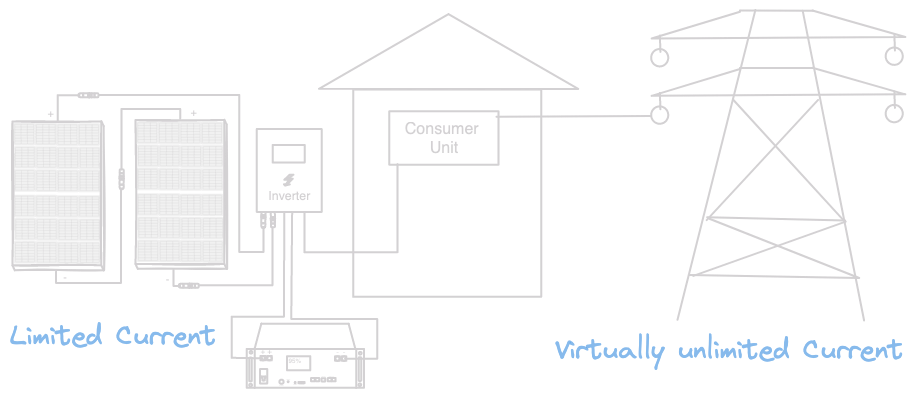
What Happens If I Have Too Many Solar Panels?
If your panels are connected series, there will be a point at which you will exceed the inverter’s voltage. The same applies to charge controllers. Exceeding the voltage is dangerous and will damage your inverter. It is also a fire hazard, as increased voltage will cause smoke or sparks in the inverter.
As discussed above, there is a safe margin for expansion. It is listed on your inverter’s technical specifications.
What Are The Disadvantages Of Overpaneling
As with everything else, there are a couple of disadvantages to overpaneling, too. Depending on your circumstances, these may be significant points. Noteworthy disadvantages:
- Unrealised potential during optimal conditions.
- There is a danger of damage to your equipment in case of faults.
I am covering only these two as I think they are most likely to be a decision making factors. Let’s address each of these in more detail.
Unrealised Potential During Optimal Conditions
On days with optimal conditions each of your panels will be able to produce its peak rated power. However, your inverter will be a limiting factor. Hence you will only produce as much AC as your inverter is rated for. As a result, you will leave unrealised potential.
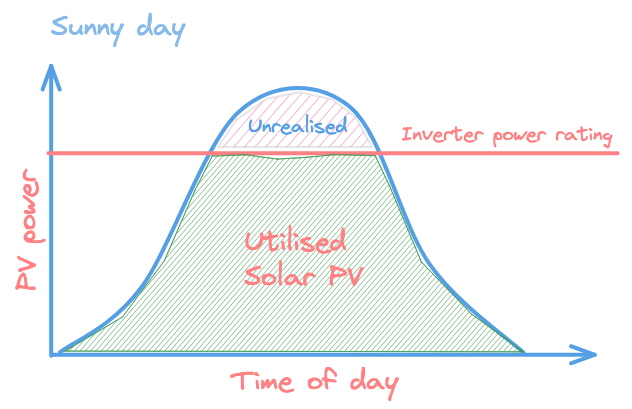
There are mitigating factors around this, though. As we have seen earlier, your inverter’s efficiency increases when the inverter operates nearer to its rated power. Therefore, the loss from unrealised potential is partially offset by increased efficiency during otherwise sub-optimal days.
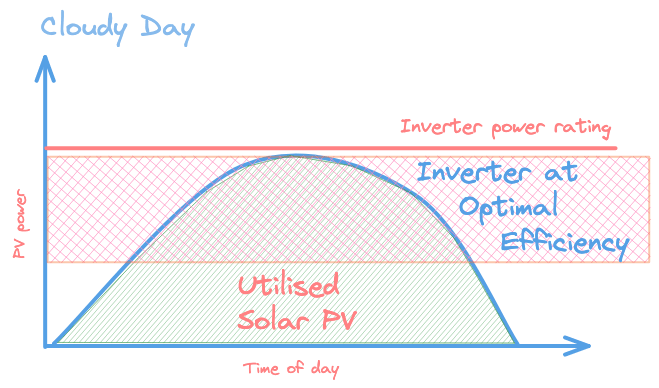
Danger of Damage to Your Equipment in Case of Faults
One of the options for overpaneling is to connect strings in parallel. Parallel strings cap the maximum voltage and increase the potential maximum current. The maximum current available to your equipment in case of faults such as short circuits is the danger. Without overpaneling, your equipment may tolerate the maximum current, even in a short circuit. However, the extra current can make a previously tolerable fault too much to handle.
Conclusion
In conclusion, overpaneling is a promising solution for maximising solar energy harvest and optimising system efficiency. By harnessing the power of overpaneling, homeowners can reduce dependency on conventional energy sources, lower electricity costs, and contribute to a greener future. We invite you to join the solar energy revolution and explore the possibilities of overpaneling for your home. Share your feedback, questions, and success stories with us at Solar Energy Concepts. Let’s journey towards a brighter, more sustainable tomorrow together!

